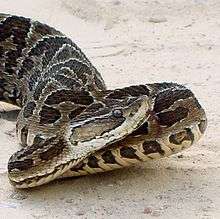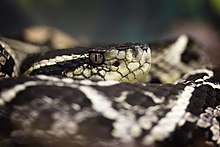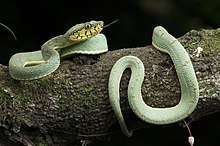Bothrops
Bothrops is a genus of pit vipers endemic to Central and South America.[1] The generic name, Bothrops, is derived from the Greek words βόθρος, bothros, meaning "pit", and ώπς, ops, meaning "eye" or "face", together an allusion to the heat-sensitive loreal pit organs. Members of this genus are responsible for more human deaths in the Americas than any other group of venomous snakes.[2] Currently, 45 species are recognized.[3]
| Bothrops | |
|---|---|
 | |
| Bothrops alternatus | |
| Scientific classification | |
| Kingdom: | Animalia |
| Phylum: | Chordata |
| Class: | Reptilia |
| Order: | Squamata |
| Suborder: | Serpentes |
| Family: | Viperidae |
| Subfamily: | Crotalinae |
| Genus: | Bothrops Wagler, 1824 |
| Synonyms | |
Description
These snakes range from small, never growing to more than 50–70 cm (19.5–27.5 in), to large at over 200 cm (6.6 ft) in total length. Most are characterized by having a sharp canthus rostralis and an unelevated snout.[2]
The arrangement of the scales on top of the head is extremely variable; the number of interorbital scales may be 3-14. Usually there are 7-9 supralabials and 9-11 sublabials. There are 21-29 rows of dorsal scales at midbody, 139-240 ventral scales, and 30-86 subcaudals, which are generally divided.[2]
Common names
Lacépède originally applied the name "lanceheads"[2] to all of these snakes, which he considered conspecific. Thus, older writings, as well as popular and sometimes scientific writings (including the American Heritage, Merriam-Webster, and New Shorter Oxford dictionaries), still often call them fer-de-lance (French, "spearhead"). However, many scientists and hobbyists now restrict this name to the Martinican species, B. lanceolatus. Other common names include American lanceheads and American lance-headed vipers.[4]
Geographic range
Found in northeastern Mexico (Tamaulipas) southward through Central and South America to Argentina, Bothrops species also occur on the islands of Saint Lucia and Martinique in the Lesser Antilles, as well as on Ilha da Queimada Grande off the coast of Brazil.[1] B. atrox is also found on the island of Trinidad in the Southern Caribbean off the eastern coast of Venezuela.
Behavior

Most species are nocturnal, although a few found at higher altitudes are active during the day. Otherwise, they may be seen on cloudy days or during periods of rain. Most are terrestrial, though all are capable of climbing. One species, B. insularis, which is endemic to Ilha da Queimada Grande, is considered to be semiarboreal. This species, unlike most Bothrops, preys primarily on birds, due to the absence of native mammal species on Queimada Grande. This feeding habit probably accounts for their more arboreal lifestyle compared with their mainland cousins.[2] Many species of Bothrops exhibit tail vibration behavior when disturbed.[5]
Venom
Members of this genus are responsible for more fatalities in the Americas than any other group of venomous snakes. In this regard, the most important species are B. asper, B. atrox and B. jararaca. Without treatment, the fatality rate is estimated to be about 7%, but with treatment this is reduced to 0.5-3%.[2]

Typical symptoms of bothropic envenomation include immediate burning pain, dizziness, nausea, vomiting, sweating, headache, massive swelling of the bitten extremity, hemorrhagic blebs, local necrosis, bleeding from the nose and gums, ecchymosis, erythemia, hypotension, tachycardia, coagulopathy with hypofibrinogenemia and thrombocytopenia, hematemesis, melena, epistaxis, hematuria, intracerebral hemorrhage and kidney failure secondary to hypotension and bilateral cortical necrosis. There is usually some discoloration around the bite site, and rashes may develop on the torso or the extremities.[2]
In general, death results from hypotension secondary to blood loss, kidney failure, and intracranial hemorrhage. Common complications include necrosis and kidney failure secondary to shock and the toxic effects of the venom.[2]
Species
| Species[3] | Taxon author[3] | Subsp.*[3] | Common name[2] | Geographic range[1] |
|---|---|---|---|---|
| B. alcatraz | Marques, Martins, & Sazima, 2002 | 0 | Northeastern Brazil. | |
| B. alternatus | A.M.C. Duméril, Bibron & A.H.A. Duméril, 1854 | 0 | Urutu, yarará, víbora de la cruz | Southeastern Brazil, Paraguay, Uruguay and northern Argentina (in the provinces of Buenos Aires, Catamarca, Córdoba, Corrientes, Chaco, Entre Ríos, Formosa, La Pampa, Misiones, San Luis, Santa Fe, Santiago del Estero and Tucumán. |
| B. ammodytoides | Leybold, 1873 | 0 | Patagonian lancehead | Argentina in the provinces of Buenos Aires, Catamarca, Córdoba, Chubut, La Pampa, La Rioja, Mendoza, Neuquén, Río Negro, San Juan, San Luis, Santa Cruz and Tucumán |
| B. asper | (Garman, 1884) | 0 | terciopelo (preferred), Fer-de-lance (commonly used, but incorrect) | Atlantic lowlands of eastern Mexico and Central America, including Guatemala, Belize, Honduras, Nicaragua, Costa Rica and Panama, a disjunct population occurs in southeastern Chiapas (Mexico) and southwestern Guatemala, northern South America in Colombia and Venezuela[1] Also in Ecuador.[2] |
| B. atrox | (Linnaeus, 1758) | 0 | Common lancehead | Tropical lowlands of South America east of the Andes, including southeastern Colombia, southern and eastern Venezuela, Guyana, Surinam, French Guiana, eastern Ecuador, eastern Peru, northern Bolivia and the northern half of Brazil |
| B. ayerbei | Folleco-Fernandez, 2010 | 0 | Patian lancehead, Ayerbe's lancehead | Cauca, Colombia |
| B. barnetti | Parker, 1938 | 0 | Barnett's lancehead | Along the Pacific coast of northern Peru at low elevations in arid, tropical scrub |
| B. bilineatus | (Wied-Neuwied, 1825) | 2 | Two-striped forest-pitviper | Amazon region of South America: Colombia, Venezuela, Guyana, Surinam, French Guiana, Brazil, Ecuador, Peru and Bolivia. An isolated population is known from the Atlantic versant of southeastern Brazil. |
| B. brazili | Hoge, 1954 | 0 | Brazil's lancehead | Equatorial forests of southern Colombia, eastern Peru, eastern Ecuador, southern and eastern Venezuela, Guyana, Surinam, French Guiana, Brazil and northern Bolivia |
| B. caribbaeus | (Garman, 1887) | 0 | Saint Lucia lancehead | St. Lucia, Lesser Antilles, apparently restricted to the low elevation periphery of all but the southern third and extreme northern tip of the island |
| B. chloromelas | (Boulenger, 1912) | 0 | central Andes of Peru | |
| B. cotiara | (Gomes, 1913) | 0 | Cotiara | Araucaria forests of southern Brazil in the states of São Paulo, Paraná, Santa Catarina and Rio Grande do Sul, northeastern Argentina in Misiones Province |
| B. diporus | Cope, 1862 | 0 | Painted Lancehead | Argentina, Brazil, Paraguay, Bolivia |
| B. erythromelas | Amaral, 1923 | 0 | Caatinga lancehead | Northeastern Brazil in the states of Alagoas, Bahia, Ceará, extreme eastern Maranhão, Minas Gerais, Paraíba, Pernambuco, Piauí, Rio Grande do Norte and Sergipe |
| B. fonsecai | Hoge & Belluomini, 1959 | 0 | Fonseca's lancehead | Southeastern Brazil in the states of northeastern São Paulo, southern Rio de Jeneiro and extreme southern Minas Gerais |
| B. insularis | (Amaral, 1922) | 0 | Golden lancehead | Queimada Grande Island, Brazil |
| B. itapetiningae | (Boulenger, 1907) | 0 | São Paulo lancehead | Southeastern Brazil in the states of Minas Gerais, Mato Grosso, São Paulo, and on the Paraná Plateau |
| B. jararaca | (Wied-Neuwied, 1824) | 0 | Jararaca | Southern Brazil, northeastern Paraguay and northern Argentina (Misiones) |
| B. jararacussu | Lacerda, 1884 | 0 | Jararacussu | Eastern Brazil (from Bahia to Santa Catarina), Paraguay, southeastern Bolivia and northeastern Argentina (Misiones Province) |
| B. jonathani | (Harvey, 1994) | 0 | Cochabamba lancehead | The Altiplano of central Bolivia in the department of Cochabamba, occurring at elevations of 2800–3200 m in dry, rocky grassland |
| B. lanceolatusT | (Bonnaterre, 1790) | 0 | Fer-de-lance, Martinique lancehead | Martinique, Lesser Antilles |
| B. leucurus | Wagler, 1824 | 0 | Bahia lancehead | Eastern Brazil along the Atlantic coast from northern Espírito Santo north to Alagoas and Ceará, occurs more inland in several parts of Bahia, uncertain identity of disjunct populations west of the Rio São Francisco |
| B. lutzi | (Miranda-Ribeiro, 1915) | 0 | Cerrado lancehead | Northeastern Brazil in northern Piaui state |
| B. marajoensis | Hoge, 1966 | 0 | Marajó lancehead | Northern Brazil in the coastal lowlands of the Amazon Delta |
| B. marmoratus | Da Silva & Rodrigues, 2008 | 0 | Marbled lancehead | Goiás, Brazil |
| B. mattogrossensis | Amaral, 1925 | 0 | Brazil, Bolivia, Argentina, Peru | |
| B. medusa | (Sternfeld, 1920) | 0 | Venezuelan forest-pitviper | Venezuela, including the Cordillera de la Costa (coastal range), the Federal District and the states of Aragua, Bolívar and Carabobo. |
| B. monsignifer | Timms, Chaparro, Venegas, Salazar-Valenzuela, Scrocchi, Cuevas, Leynaud, & Carrasco, 2019 | 0 | Bolivia | |
| B. moojeni | Hoge, 1966 | 0 | Brazilian lancehead | Central and southeastern Brazil, eastern Paraguay, northeastern Argentina (Misiones) and likely eastern Bolivia |
| B. muriciensis | Ferrarezzi & Freire, 2001 | 0 | Northeastern Brazil | |
| B. neuwiedi | Wagler, 1824 | 7 | Neuwied's lancehead | South America east of the Andes and south of 5°S, including Brazil (southern Maranhão, Piauí, Ceará, Bahia, Goiás, Mato Grosso, an isolated population in Amazonas, Rondônia and all southern states), Bolivia, Paraguay, Argentina (Catamarca, Córdoba, Corrientes, Chaco, Entre Ríos, Formosa, Jujuy, La Pampa, La Rioja, Mendoza, Misiones, Salta, San Juan, San Luis, Santa Fe, Santiago del Estero and Tucumán) and Uruguay |
| B. oligolepis | (F. Werner, 1901) | 0 | Peruvian forest-pitviper | Eastern slopes of the Andes in Peru and Bolivia. |
| B. osbornei | Freire-Lascano, 1991 | 0 | Ecuador, Northwestern Peru | |
| B. otavioi | Barbo, Grazziotin, Sazima, Martins, & Sawaya, 2012 | 0 | São Paulo, Brazil | |
| B. pauloensis | Amaral, 1925 | 0 | Brazil, Paraguay, Bolivia | |
| B. pictus | (Tschudi, 1845) | 0 | Desert lancehead | Peru on the hills of the Pacific coastal region and versant up to about 1800 m elevation |
| B. pirajai | Amaral, 1923 | 0 | Piraja's lancehead | Brazil in central and southern Bahia state and possibly also Minas Gerais |
| B. pubescens | (Cope, 1870) | 0 | Brazil, Uruguay | |
| B. pulcher | (W. Peters, 1862) | 0 | Andean forest-pitviper | Eastern slopes of the Andes from south-central Colombia to southern Ecuador. |
| B. punctatus | (García, 1896) | 0 | Chocoan lancehead | From the Darién of Panama along the Pacific slope of Colombia and Ecuador to extreme northern Peru. |
| B. sanctaecrucis | Hoge, 1966 | 0 | Bolivian lancehead | Bolivia in the Amazonian lowlands from the departments of El Beni to Santa Cruz |
| B. sazimai | Barbo, Gasparini, Almeida, Zaher, Grazziotin, Gusmão, Ferrarini, & Sawaya, 2016 | 0 | Franceses Island lancehead | Ilha dos Franceses, Brazil |
| B. sonene | Carrasco, Grazziotin, Cruz-Farfan, Koch, Ochoa, Scrocchi, Leynaud, & Chaparro, 2019 | 0 | Madre de Dios, Peru | |
| B. taeniatus | (Wagler, 1824) | 2 | Speckled forest-pitviper | Widespread in the equatorial forests of Ecuador, Colombia, Venezuela, Guyana, Suriname, French Guiana, Brazil, Peru and Bolivia. |
| B. venezuelensis | Sandner-Montilla, 1952 | 0 | Venezuelan lancehead | Northern and central Venezuela, including the Cordillera de la Costa (coast range) and the states of Aragua, Carabobo, the Federal District, Miranda, Mérida, Trujillo, Lara, Falcón, Yaracuy and Sucre |

*) Not including the nominate subspecies.
T) Type species[1]
References
| Wikimedia Commons has media related to Bothrops. |
- McDiarmid RW, Campbell JA, Touré T. 1999. Snake Species of the World: A Taxonomic and Geographic Reference, vol. 1. Herpetologists' League. 511 pp. ISBN 1-893777-00-6 (series). ISBN 1-893777-01-4 (volume).
- Campbell JA, Lamar WW. 2004. The Venomous Reptiles of the Western Hemisphere. Comstock Publishing Associates, Ithaca and London. 870 pp. 1500 plates. ISBN 0-8014-4141-2.
- "Bothrops". Integrated Taxonomic Information System. Retrieved 3 November 2006.
- U.S. Navy. 1991. Poisonous Snakes of the World. US Govt. New York: Dover Publications Inc. 203 pp. ISBN 0-486-26629-X.
- Allf, Bradley C., Paul AP Durst, and David W. Pfennig. "Behavioral Plasticity and the Origins of Novelty: The Evolution of the Rattlesnake Rattle." The American Naturalist 188.4 (2016): 475-483

External links
- Bothrops at the Reptarium.cz Reptile Database. Accessed 6 December 2007.